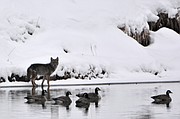Canada geese: Boundary County’s winter honkers
Don Bartling | Hagadone News Network | UPDATED 5 years, 10 months AGO
“... whoever you are, no matter how lonely the world offers itself to your imagination, calls to you like the wild geese, harsh and exciting — over and over announcing your place in the family of things.”
— Mary Oliver
I listened intently! A sound like a big crowd a good way off beyond the Kootenai River, excited and shouting, getting closer. I stood up and scanned the empty sky. Suddenly there they are (the geese), a wavering V headed directly over the hilltop, quite low, beating southward down to the fields and talking as they pass. I stay quiet suspending my thoughts until their gabbing fades and their wavering lines are invisible in the sky.
I felt a rich experience with nature that wasn’t there before they came.
Canada geese, or “honkers” as they are often referred to, reside year-long in Boundary County. However, the numbers peak in the winter, when resident birds join with migratory flocks. These birds feed during the winter months on waste grain from agricultural fields and they roost on various stretches of the Kootenai River.
At least 12 subspecies of Canada geese exist, ranging from the smallest, the Cackling Canada goose, weighing three pounds, to the Giant Canada goose weighing nearly 20 pounds. Canada geese found in the Kootenai River Valley weigh about 10 to 12 pounds and are one of the larger subspecies recognized. They have expanded their breeding range throughout the 11 western states, often nesting on elevated muskrat mounds, or islands, but also respond well to manmade nesting structures.
Canada geese also nest in trees and on cliffs, with females incubating four to eight eggs. Early accounts from the Lewis and Clark expedition refer to geese nesting in trees along the rivers they traveled. I have witnessed Canada geese nesting 20 feet high in a cottonwood tree on Myrtle Creek, which must be quite a drop for the hatchlings, which basically float to the ground due to their down puff-ball type appearance.
Canada geese mate for life. However, if one of the pair is lost to hunters or natural mortality, the surviving goose will re-mate with another lone goose. The male will serve as a nest guard and if you approach an occupied nest, you can observe the female dropping her neck down, attempting to hide until you cross the magical barrier that ignites quite a fury of honking alarm calls. Once hatched, the goslings will feed primarily on insects to build up protein reserves. By late summer, these birds are ready for flight.
Many geese don’t migrate as far south as they once did because some farming practices make waste grain more available in the fall and winter. The geese that spend the summer here may winter here or fly south. Wintering geese may be resident geese or migrants from farther north.
Not all geese migrate either. Some Canada geese are considered resident geese because they stay year-round in places with open water and available food. A goose is taught to migrate by its parents and if they don’t migrate then the young don’t migrate.
Canada geese are highly adaptable to what food is available and will eat grass, leaves, flowers, roots, seeds, berries, and crops such as barley, wheat, alfalfa, and corn. They also eat aquatic plants and the occasional insect, tadpole or snail.
Despite their noisiness and ability to make 13 different calls, the Canada goose still has several predators. When molting, sitting on the nest and eggs, the geese are most vulnerable to coyotes, wolves, raccoons, skunks, bobcats, foxes, gulls, eagles, ravens, magpies and crows.
While they can be a nuisance at times, this majestic bird with its black head and white cheek patch, along with its unmistakable, “ahonk, ahonk, ahonk” is one of our valley’s most recognizable birds both for the hunters and bird watchers alike.
Enjoy Boundary County and its wildlife!
ARTICLES BY DON BARTLING

Myrtle Falls Trail: A short hike with a spectacular view

Common mullein: An amazing, versatile plant
As I was taking a walk earlier this summer, I noticed along the bank of the Kootenai River some green, soft-looking plants which appeared to be the lambs-ear plant, with which many of us are familiar.

Dog days of summer are upon us
According to Wikipedia “The dog days or dog days of summer (July 22, 2020-Aug. 22, 2020) are the hot, sultry days of summer. They were historically the period following the heliacal rising of the star system Sirius, which Hellenistic astrology connected with heat, drought, sudden thunderstorms, lethargy, fever, mad dogs, and bad luck.”



